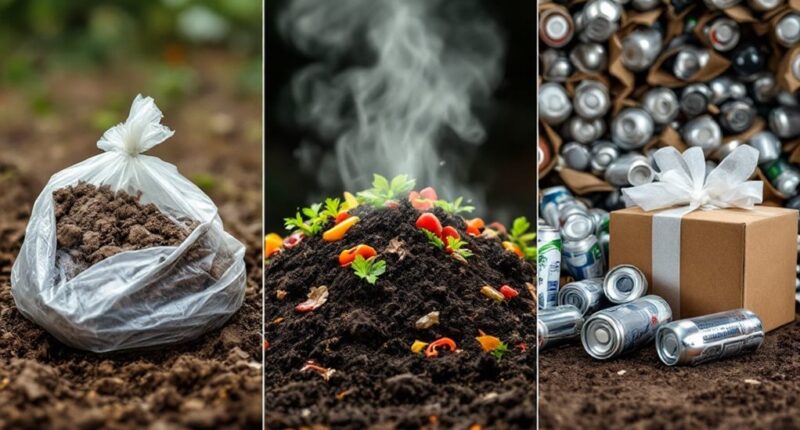Biodegradable materials break down naturally but may leave harmful residues, while compostable items decompose into non-toxic components within 180 days under specific conditions. Recyclable materials can be transformed into new products, conserving resources. Proper disposal is essential—biodegradables shouldn’t go in recycling bins, compostables need special facilities, and recyclables require correct sorting. Think of them as three distinct environmental solutions, each with their own rulebook. The key differences determine their true environmental impact.

Confusion reigns supreme in the world of sustainable materials, where terms like “biodegradable,” “compostable,” and “recyclable” are often tossed around as casually as plastic bags in a windstorm.
These eco-friendly descriptors might sound interchangeable, but they’re about as similar as a dolphin, a shark, and a submarine—all operate in water, but with vastly different mechanisms.
Biodegradable materials, nature’s slow dissolvers, break down through microbial action over time spans ranging from months to millennia. Think of them as the procrastinators of the waste world: they’ll decompose eventually, but don’t hold your breath.
Biodegradables: Earth’s lazy roommates who promise to clean up after themselves… eventually.
While they do disintegrate, they often leave behind harmful residues or microplastics—the environmental equivalent of ditching a party but leaving your empty cups everywhere.
Compostable materials, meanwhile, are the overachievers of the bunch. They break down completely into non-toxic components within a brisk 180 days, but only under specific conditions found in industrial composting facilities.
They’re like those friends who thrive only in particular environments—put them in a regular landfill, and they’ll sulk indefinitely. Industrial facilities create optimal environments by controlling factors like moisture and temperature, which most home composting systems cannot replicate. The good news? They’re regulated, certified, and create nutrient-rich soil as their grand finale.
Recyclable materials are the reincarnation enthusiasts—metals, glass, paper, and certain plastics that can be processed and reborn as new products. They help conserve natural resources faster than a squirrel hoards nuts, but their afterlife depends entirely on local recycling capabilities.
And beware—contamination can compromise an entire batch faster than one sneeze at a buffet.
The environmental impact hierarchy generally crowns compostable materials as champions, while biodegradables might release methane in landfills like silent saboteurs. Biodegradable materials can decompose through aerobic or anaerobic processes, with the latter potentially creating valuable combustible gases like methane when properly harnessed.
Recycling saves energy and reduces greenhouse gas emissions, but improper disposal of any material negates benefits faster than a delete key erases a regrettable email.
Choosing sustainable packaging options can significantly reduce your environmental footprint while meeting your specific containment needs.
For ideal planet-saving, remember this: biodegradables don’t belong in recycling bins, compostables need special facilities, and recyclables require proper sorting.
The future looks promising with innovations in sustainable materials—if we can just figure out where to throw them.
Frequently Asked Questions
How Do Weather Conditions Affect Biodegradation Rates?
Weather conditions greatly impact biodegradation rates.
Temperature acts as nature’s speedometer—warmer conditions accelerate microbial activity, while freezing temperatures slow it down.
Moisture is equally critical, with ideal biodegradation occurring at 30-90% water saturation.
Oxygen availability determines whether faster aerobic or slower anaerobic processes dominate.
Additionally, rainfall can affect soil pH and nutrient distribution.
These environmental factors collectively determine how quickly materials break down in natural settings.
Can Compostable Items Break Down in Landfills?
Compostable items rarely break down effectively in landfills.
Without oxygen, moisture, and proper microbial activity, these materials enter a slow, anaerobic decomposition process that can take decades rather than weeks.
Instead of producing nutrient-rich compost, they release methane—a potent greenhouse gas 28-36 times more powerful than CO2.
What should become valuable soil amendment remains trapped, with even “certified compostable” products unable to fulfill their environmental promise in these oxygen-deprived conditions.
Which Industries Produce the Most Recyclable Waste?
The construction and demolition industry generates the largest volume of recyclable waste, producing 600 million tons of debris annually in the US.
Manufacturing follows closely behind, creating 7.6 billion tons of industrial waste globally each year.
Retail businesses contribute significant amounts of cardboard and packaging materials, while municipal solid waste—though smaller in volume—contains highly recyclable materials like paper (23.1%), plastics (12.2%), and metals (8.8%) from everyday consumer activities.
Are Biodegradable Plastics Safe for Marine Environments?
Despite their eco-friendly label, biodegradable plastics aren’t safe for marine environments.
Research shows they persist for years, fragmenting into harmful microplastics while leaching toxic additives. The ocean’s low temperatures, insufficient oxygen, and lack of necessary microorganisms prevent proper breakdown—one study found PLA decreased only 2.5% after 600 days in simulated marine conditions.
These materials pose similar entanglement and ingestion risks to marine life as conventional plastics, with misleading labeling often confusing consumers about their true impact.
Do Compostable Products Require Special Disposal Facilities?
Yes, compostable products absolutely require special disposal facilities.
Despite their eco-friendly image, these materials need specific conditions to properly break down. Industrial composting facilities maintain precise temperature, humidity, and microbial activity levels that landfills and backyard compost piles simply can’t match.
Without these controlled environments, compostable items can linger for years, fundamentally acting like conventional plastics. Some products are certified for home composting, but most need industrial facilities to fulfill their biodegradable promise.









